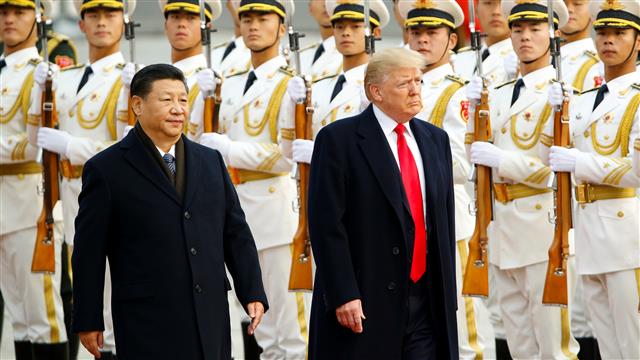
Chinese President Xi Jinping welcomes U.S. President Donald Trump to Beijing. Photo courtesy of Reuters.
Any kind of security or economic paradigm in Asia which does not include China is doomed to failure. Structures which have failed to take into account the interests of a region’s dominant, or near-dominant, power have failed both in the recent, and not-so-recent past.
From the German perspective, World War II was practically preordained based on its treatment at Versailles post-World War I. The excessive reparations demanded of it further depressed its postwar economy, which was itself a contributing factor to the rise of fascism and eventual rearmament of Germany in relatively short order. It wasn’t until Germany was defeated again (and partitioned) that it received economic assistance through the Marshall Plan.
In more modern times, the failure to include Russia and its interests in any post-Cold War security architecture on the European continent has led directly to today’s Ukraine Crisis. This idea of a more inclusive arrangement, acknowledging Russia’s legitimate security interests in Europe was voiced most recently by Russian President Putin, but actually goes back further to former Russian President Yeltsin’s original hope for Russian membership within NATO itself. Additionally, for acknowledging “losing” the Cold War, an economically devastated Russia, circa the 1990s, expected massive financial assistance from the West, akin to the above-mentioned Marshall Plan.
Disappointingly, this assistance never materialized. However, economics was just as important a factor as security concerns in the Ukraine Crisis as one of the causes was Ukraine’s economic alignment. Disagreement over whether the EU or the Eurasian Economic Union (EEU) offered the best path forward for Ukraine led Ukraine’s leaders to play both sides off against one another. A Russian solution for Ukraine to potentially be part of both blocks was jettisoned by the EU due to the exclusive nature of its own proposition, leading to Ukraine’s refusal of the EU solution, the Euromaidan Revolution, and thus the current crisis.
The TPP was originally designed to exclude China, the leading trading partner of most states in its region. In its modified form even after the U.S.’ departure, the Comprehensive and Progressive Agreement for Trans-Pacific Partnership (CPTPP), or “TPP-11”, still follows this model, to its own detriment. Currently, China has argued for keeping its own economy open to the world even as the U.S. becomes more protectionist in nature. The case can not even be made by the U.S. that the CPTPP is a community of states based on shared liberal values, like democracy, therefore China’s exclusion is logical, as Vietnam is still a CPTPP member. The current G-7 meeting in Canada deftly illustrates how trading groups based on shared values, and not reality, can quickly become anachronistic.
India is currently being wooed by the U.S. in its efforts to balance China in Asia. However, the U.S.’ current use of the term “Indo-Pacific” over “Asia-Pacific” is not enough to make India forget its own historically non-aligned stance and overriding desire for strategic autonomy. Of course, India has its own issues with China, ranging from the Doklam Crisis last year, to continuing concerns over the China–Pakistan Economic Corridor (CPEC). Apparently, however, India has decided that any kind of Indo-Pacific paradigm must not exclude or target states like (but especially) China, which may or may not share similar democratic values with India or the U.S.. India has referred to the “Indo-Pacific” as a geographic concept, not a strategic one.
This Indian standpoint complicates U.S. wishes to enlist it, Japan, and Australia into a “Diamond of Democracies” (Japan’s original term) targeting China. This renamed “Quad” forms the core of the U.S.’ Indo-Pacific strategy to address regional issues, such as securing freedom of navigation rights in the South China Sea. Some have even called for Taiwan to be included in this grouping. Further complications arise from India’s desire to import energy from Iran and weaponry from Russia as both states are currently under U.S. sanctions. The U.S. strategy to further marginalize China within its own region by recruiting the U.K. and France as potential FONOP partners reeks of historial amnesia as these states are still lumped together by Asian nations with others such as Spain, Portugal, and The Netherlands as former colonial powers. Lastly, the move is highly risky as it might invite even further Russian naval maneuvers in the region as a show of support for China.
Lastly, depite both Indian and U.S. reassurances at the recent IISS Shangri-La Dialogue of ASEAN centrality in any Indo-Pacific paradigm, ASEAN is still hesitant to sign up to anything which would excessively marginalize China, the largest trading partner for many of its members. Yes, many Southeast Asian states still desire security from the U.S., while simultaneously continuing trading linkages with China. While, like Ukraine, ASEAN is leveraging its geographic position to gain maximum dividends from all outside parties (Japan, Russia, and India, too), it draws the line at membership in any structure or paradigm where it would explicitly be asked to choose between China and the U.S.. Therefore, as the linkages between trade and security become ever more complex in the future, more inclusive groupings such as China’s RCEP and India’s SAGAR, though not perfect, may offer a better chance of success in the long-term.